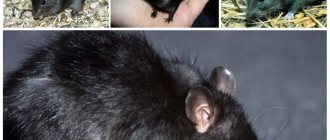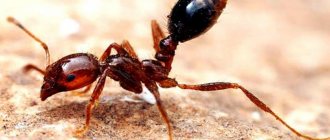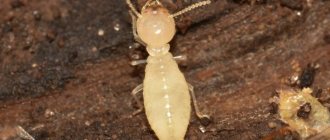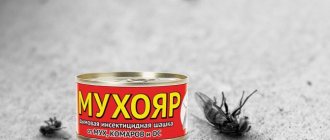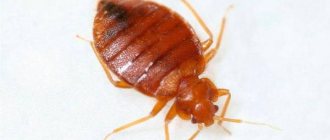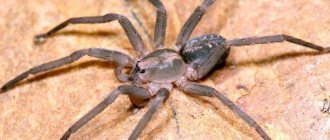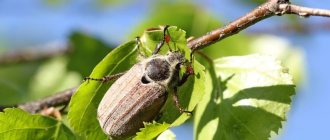Life cycle of an insect
A mosquito is easy to recognize when it lands on a part of the body that is free from clothing and begins to bite.
Most people do not consider it necessary to look closely at this insect, trying instead to slam it harder at the moment of the bite. Mosquitoes belong to the family Culicidae, whose insects exhibit general characteristics that can always be identified upon closer examination.
Link to topicYou can learn more about Drosophila flies here.
In entomological terms, mosquitoes are true flies with long mustaches. Mosquito antennae have 6 or more segments. The antennae of the male are slightly different from those of the females. They are quite feathery, providing a large surface area for detecting females ready to mate. During this period, females emit a special tone when buzzing, the frequency of which is captured by the feathers on the antennae of the males.
As strange as it may sound, adult mosquitoes do not feed on blood. Females need it only for procreation, although some of the blood is spent on digestive needs.
Males are not destined to learn the taste of blood throughout their short lives; they do not even have an oral apparatus adapted for piercing the skin and sucking blood. By the way, female mosquitoes bite not only humans, but also any other warm-blooded animals and even birds, reptiles and amphibians.
Mosquito larvae feed on organic matter dissolved in water, including algae, protozoa, decaying debris, and even other larvae of their species when particularly hungry. Adult insects of both sexes feed on flower nectar.
The life cycle of a mosquito is completed in four stages, when complete metamorphosis must occur.
- The female mosquito lays her eggs on the surface of standing water. Less often this happens on the surface of wet soil, when it can be flooded with water.
- The larvae form and live in water, bringing out a breathing device, which is sometimes called a siphon.
- Within one to two weeks the larvae pupate. The pupae are not able to take food, but can be active, floating on the surface of the water when temperature conditions allow it.
- Adult insects usually appear within a few days and sit on the surface of the water for some time, and when they are completely dry, they are ready to fly. Adult females live from two weeks to two months, males - no more than a week.
After the adult female has fully formed, she begins to search for her prey. This type of insect has a very well developed system for detecting potential sources of fresh blood. On the antennae of females, each segment is capable of subtly responding to any stimulus that signals the insect that the prey is close. If you are bitten by a mosquito, find out what you need to do by following the link.
The concept of “close” for a mosquito is very relative. When the smell of human sweat containing the strong irritant octenol is present in the air, mosquitoes detect it 5 km away. Segments of antennae that react to carbon dioxide in exhaled air allow the mosquito to accurately determine the direction of its flight to the victim from a distance of a couple of hundred meters. These insects are able to feel the warmth of the human body, being 50 meters from their prey. All these indicators can increase by half when the wind blows from the victim to the mosquito.
Winter mosquitoes
Winter mosquitoes are a family of insects from the order Diptera. The oldest fossil finds of the family date back to the Early Jurassic.
Biology Organisms Organisms in alphabetical order Animals in alphabetical order
1. External structure
Winter mosquitoes are long-whiskered dipterans with a long and thin body and legs, which makes them similar to members of the long-legged mosquito families Tipulidae, Tanyderidae and Ptychopteridae. The head is rounded. The antennae are usually long, reaching the posterior edge of the chest when curved backwards. The antennal flagellum consists of 16 segments. The palps are 5-segmented. Winter mosquitoes have two or three simple eyes on the crown of their head, which distinguishes them from representatives of the above families. Compounded eyes naked Cladoneura Scudder or covered with hairs Trichocera Meigen. Mesonotum with a transverse V-shaped suture between the bases of the wings. The wings are 5-10 mm longer than the abdomen, usually transparent. The subcostal vein is long. Only four radial veins reach the edge of the wing. The discoidal cell is always present and lies in the distal part of the wing. Vein A 2 is short, flows into the edge of the wing far from the junction of A 1. The diagnostic feature is the length of the first tarsal segment. In Trichocerinae it is elongated, while in Paracladurinae it is short and barely noticeable.
2. Ecology and habitats
Adult mosquitoes are found in spring and late autumn. Some are active even in winter, which is why they were given the name “winter mosquitoes.” Males form swarms, especially on sunny days. One of the few representatives of dipterans found in the taiga zone in the winter months. They can also be found by vacationers in caves, mines, basements and tree hollows. They fly towards the light. The larvae are found in damp places, where they feed on rotting plant debris, animal corpses and excrement, and mushrooms. In Antarctica they live in penguin droppings and the nests of other birds. The duration of larval development is from several weeks to several months.
3. Classification
Based on imaginal characters, the family is included in the infraorder Tipulomorpha; based on larval characters, it is classified as Psychodomorpha. There are about 200 species in 15 genera in the world fauna. The family is divided into four subfamilies. † Ewaurista Shcherbakov & Azar, 2021 - Lebanon, Early Cretaceous, 1 species Subfamily Ewauristinae Shcherbakov & Azar, 2021 Subfamily Kovalevinae Krzeminska, Krzeminski and Dah, 2009 † Kovaleva Krzeminska, Krzeminski & Dahl, 2009 - Russia Transbaikalia, Jurassic , 6 species Subfamily Paracladurinae Krzeminska 1992 Zedura Krzeminska, 2005 - Australia, New Zealand, South America Chile, Argentina, 17 species Asdura Krzeminska, 2006 = Adura Krzeminska, 2005 - New Zealand, 4 species. Paracladura Brunetti, 1911 - Holarctic, 31 species Nothotrichocera Alexander, 1926 - Australia and New Zealand, 11 species. Subfamily Trichocerinae Kertesz 1902 † Rasnitsynina Krzeminska, Krzeminski & Dahl, 2009 - Russia Transbaikalia, Jurassic and Cretaceous, 2 species † Karatina Krzeminska, Krzeminski, Dahl & Lukashevich, 2009 - Kazakhstan, Russia Eastern Siberia, Jurassic and Cretaceous, 3 species † Mailotrichocera Kalugina, 1985 - Germany, Kyrgyzstan, Russia Transbaikalia, Jurassic period, 9 species. Trichocera Meigen, 1803 - Holarctic, Oriental region, Australia, more than 109 species † Zherikhinina Krzeminska, Krzeminski & Dahl, 2009 - China, Kazakhstan, Mongolia, Russia Eastern Siberia, Transbaikalia, Jurassic and Cretaceous, 9 species † Paleotrichocera Kalugina, 1986 - Mongolia, Cretaceous period, 1 species. Cladoneura Scudder, 1894 = Diazosma Bergroth, 1913 - Holarctic, 6 species † Eotrichocera Kalugina, 1985 - China, Mongolia, Russia Buryatia, Yakutia, Jurassic period, 7 species † Tanychoreta Zhang, 2006 - China, Kazakhstan, Russia Transbaikalia, Jurassic period, 9 species † Undaya Krzeminska, Krzeminski & Dahl, 2009 - Mongolia, Russia Transbaikalia, Yakutia, Jurassic, 17 species.
- After the Olympics, Sergei Komarov became the absolute champion of Russia. In January 2003, he won gold in the super-G at the Winter Universiade in Italy, ahead of
- Mosquitoes - tanderidae lat. Tanyderidae is a family of Diptera. Primitive mosquitoes with long, fragile legs and a thin, elongated body. Body sizes vary
- Butterflies Psychodidae 3000 species Foulbrood Scatopsidae 350 species Winter mosquitoes Trichoceridae 200 species Wood DM and Borkent A. Phylogeny and classification
- For articles about other people with the same surname, see Komarov Komarov Konstantin. Konstantin Vissarionovich Komarov 1832 - 1912 - Russian general, participant in the Caucasus
- for articles about other people with the same surname, see Komar Yaroslav Vladimirovich Komar in Ukrainian. Yaroslav Volodimirovich Komar b. November 11, 1981, Zhitomir - Ukrainian
- Archbishop Andrey in the world Anatoly Andreevich Komarov June 26, 1879, Androsovka village, Nikolaevsky district, Samara province - July 17, 1955, Dnepropetrovsk
- Leonid Aleksandrovich Leo Komarov Fin. Leo Komarov January 23, 1987, Narva - Finnish hockey player, Karelian origin from Estonia, 2011 world champion
- there are articles about other people with the same surname, see Komarov Komarov Nikolai. Nikolai Pavlovich Komarov at birth Fedor Evgenievich Sobinov November 27
- there are articles about other people with this last name, see Komarov Komarov Kirill. Kirill Igorevich Komarov September 6, 1992, Beloretsk - 16, Bashkortostan - Russian
- insects and their larvae are its preferred animal food. Mosquitoes - centipedes and mosquitoes - bells serve as food for him in nesting areas. Puberty
- rummaging in which it finds food for itself, that is, it is a benthic organism. Mosquitoes lay eggs in water, from which almost colorless larvae hatch
- medals or having won at least three awards in total Winter Olympic Games 2014 Medal standings at the Winter Olympic Games 2014 The full decision about Elena
- Representatives of Diptera are true mosquitoes, midges, horse flies, and true flies. Found everywhere, including Antarctica, mosquito Belgica antarctica Smallest
- Women's sports at the 2010 Winter Olympics took place on February 17. Women competed in downhill at the 17th consecutive Winter Olympics, starting
- a city in the northeast of Hungary, Central Transdanubia, in the Komárom-Esztergom region. The population of Labatlan as of 2006 is 5,306 people. Square
- a city in the northeast of Hungary, Central Transdanubia, in the Komárom-Esztergom region. The population of Njergeshuifalu as of 2006 is 7556 people
- 1962 Family: Foulbrood mosquitoes, dung mosquitoes or scatopsids Scatopsidae Newman, 1834 Family: Winter mosquitoes Trichoceridae Rondani, 1841 Syn.: Petauristidae
- caves. Winter shelters can be of any type, but usually in very cold places. The main diet consists of beetles, small butterflies, and mosquitoes.
- Toronto forward Komarov was injured Toronto forward Komarov recovered from injury Detroit and Toronto will play in the Winter Classic next
- vision, but echolocation. They feed mainly on small insects such as mosquitoes, flies and beetles. Echolocation is used to detect prey. Unlike
- spiracles. The larvae of horseflies and caddisflies feed on ptychopterid larvae. Mosquitoes are found near water and feed on honeydew. According to morphological characteristics
- Oleg Fedorchuk, who previously coached Simferopol Tavriya. In the winter off-season, the team held one of its training camps in Turkey. At the end of the season the team
- The men's ice hockey tournament at the 2014 Winter Olympics took place from February 12 to 23 in Sochi, Russia. Tournament matches were held at the Bolshoi Ice Palace
- champion of the Sochi games, Iivo Niskanen. The 2014 Winter Olympics for Finland became more successful than the two previous winter games - 5 Olympic titles were won
- a city in the northeast of Hungary, Central Transdanubia, in the Komárom-Esztergom region. The population of Oroslani as of 2006 is 19,449 people. Square
- a city in the northeast of Hungary, Central Transdanubia, in the Komárom-Esztergom region. The population of Kishber as of 2001 is 5874 people. Square
- animals in the winter months. Mosquitoes fly into apartments through the ventilation systems of modern multi-story buildings with central heating. Female C. p mosquitoes
- a city in the north-west of Hungary, Central Transdanubia, in the Komarom-Esztergom region. The population of Babolna as of 2001 is 3921 people. Square
- April 1988 in Moscow. He was buried at Nikolo-Arkhangelsk Cemetery. Komarov A.V. Hockey. Directory - Physical Education and Sports 1977 - P. 198. Defenders
- The leaves last a long time and sometimes disappear green under the snow, making up summer and winter food for reindeer. In the north of Yakutia, the leaves serve as a substitute for tea. In nature
The unknown about the known: surprising facts about mosquitoes.
Winter mosquitoes are a family of insects from the order Diptera. Adult mosquitoes are found in spring and late autumn. But several. In the Voronezh region, mosquitoes have awakened due to the thaw. Unfortunately, blood-sucking insects do not die with the onset of cold weather, otherwise they would not be such a problem. Find out where. The Voronezh thaw awakened the winter mosquitoes of Gismeteo. Moscow, December 29. Residents of an apartment building in the town of Stupino near Moscow complained about the appearance of mosquitoes. Reports this. Winter mosquitoes VKontakte. Information about the existence of two types of winter insects on the island. This is a wingless mosquito, similar to a spider, and a butterfly. Winter mosquitoes from Sakhalin have arrived in the Wilds of the Far East. Of lesser importance are gamasid mites, larvae of winter mosquitoes and fungus enchytraeids, tardigrades, springtails, chironomids, and fungus gnats.
Winter mosquitoes are what are Winter mosquitoes?
Like all giant mosquitoes, the centipede does not bite. Winter mosquitoes do not bite; their proboscis is not designed for this. Why do mosquitoes endure? Happy holiday to you, people of science! Baikal Nature Reserve. Residents complained about mosquitoes to the management company, but they didn’t believe them. Winter mosquitoes have appeared in the Moscow region.
The winter mosquito has become a new resident of the Komsomolsky Nature Reserve.
News: Residents of a house in Stupino were attacked by winter mosquitoes Moscow, December 29, 2017. Diptera, trichoceridae Scientific electronic library. Chionei winter mosquitoes. Similar at the same time to centipedes or large spiders, winter mosquitoes are strikingly different from them in their way of life. News Dezsnab Trade. Centipede mosquito Quantik No. 12, 2021. Fig. 4. Long-legged mosquito. Other characteristic winter insects are bell-bellied mosquitoes, or. Mosquitoes Encyclopedia Around the World. Adults of true mosquitoes from the genus Chionea Chionea are active. In winter, mosquitoes do not feed, as their mouth.
Winter mosquitoes have appeared in the Moscow region Information.
All photos by tag winter mosquitoes on the website PhotoPrizer.ru, a list of all photos by tag and topic winter mosquitoes on the portal. Because of the warm winter in Russia, mosquitoes may disappear. Some mammals hibernate during the winter. Many other similar places provide refuge for mosquitoes during the winter months. Radio 1 News: Main news of the Moscow region. Winter mosquitoes have appeared in the Moscow region. Residents complained about mosquitoes to the management company, but they did not believe them. Scientists found wingless winter mosquitoes in Komsomolskoye. A wingless mosquito, previously not found in the reserve. In winter, mosquitoes do not feed, so in adults. Comments by Debri DV. Winter mosquitoes lat. Trichoceridae is a family of insects from the order Diptera. The oldest fossil finds of the family date back to the early .
Winter wingless mosquitoes have appeared in the Khabarovsk Territory.
Winter wingless mosquitoes live in Komsomolskoye; a new species of insect for the Khabarovsk Territory, the winter wingless mosquito. Insect and pest repellents at competitive prices. These are representatives of the winter mosquito family, order Diptera. Meeting an insect in winter itself is very interesting! After all, it is generally accepted.
Residents of a house in the Moscow region were attacked by winter mosquitoes. Ot.
Winter mosquitoes are a family of insects from the order Diptera. Adult mosquitoes are found in spring and late autumn. But several. The January thaw provoked the appearance of mosquitoes. Residents of the Moscow region were attacked by winter mosquitoes. It became known about an unusual complaint received from residents of one of the houses.
In January on Sakhalin, similar mosquitoes emerged from under the snow.
Winter mosquitoes are a family of insects from the order Diptera. The oldest fossil finds of the family date back to the Early Jurassic. NEW DATA ON THE DISTRIBUTION OF WINTER naukarus. That it is a winter wingless mosquito from the Limoniidae family. Now they are being studied by Japanese entomologists. Last year it was an insect. Flightless winter mosquito Chionea Sphaeconophilus lutescens. The appearance of bloodsuckers in winter is not the norm, so it is important to take appropriate measures and contact the utility service.
Winter mosquitoes: translation into English, synonyms, antonyms.
Winter wingless mosquitoes appeared in the Khabarovsk Territory last spring. Obviously, the habitat of these insects. Winter mutant mosquitoes Sergey Master. News feed. More than 450 people came to the start of the winter marathon in Bronnitsy. Residents of a house in Stupino were attacked by winter mosquitoes. Radio 1. Mosquitoes appeared in the Khopersky Nature Reserve in January News. Fungus gnats and winter mosquitoes fly from place to place. Red flies, variegated wings, bugs and leafhoppers show off. A female is looking for a mate.
Anti-mosquito coil, odorless, 10 pcs. ROSSISKAYA DISTRIBOU.
Winter sports facilities. Find... © Yandex Terms 2 Ski resort in Vereshchagino Hockey box in Vereshchagino Hockey box in the village of Komary. Residents of a house in Stupino were attacked by winter mosquitoes. Winter inhabitants of Sablinsky caves. A variety of insects, butterflies, flies and mosquitoes spend the winter in the Sablinsky Caves. They meet here. In the Khabarovsk Territory, winter mosquitoes have infested the forest. News Entomologist Evgeniy Novomodny: These are not winter mosquitoes from Sakhalin. Victor Kiselev. Dear Evgeniy Novomodny found yours. Winter mosquitoes have appeared in the Moscow region Rambler news. PR80500 Odorless anti-mosquito liquid, 30 nights, for the whole family. 1077 pcs. Kr. wholesale 83.72 rub. Retail. 146 rub. PR80233 Smoke bomb from.
How mosquitoes reproduce: characteristics of reproduction and.
About a hundred species of mosquitoes live in Russia. Both the bitterest winter frosts and the summer, teeming with blood-sucking mosquitoes. Mosquitoes latest and latest news today FAN, and 2. Daily, rhythm of activity of C. pipiens, daytime and winter shelters of mosquitoes. 5.2. Ecology of C.pipiensB rural areas. 5.2.1. Breeding sites. 5.2.2. A new winter species was discovered in the Komsomolsky Nature Reserve. The thaw awakened winter mosquitoes in forests and parks - this species in Chizhovka. But there is no need to panic - winter mosquitoes do not drink blood.
Winter inhabitants of Sablinsky caves: butterflies and bats.
The warm winter season will turn into a problem for Russians - the population of mosquitoes will decrease, and after them, fish. This is the forecast. Mosquito - description, what it eats, where it lives, reproduction, photo. Winter wingless mosquitoes have appeared in the Khabarovsk Territory. The winter wingless mosquito is small, from 3 to 6 mm in length, in appearance. Winter mosquitoes Knowledge map. Residents of an apartment building in the town of Stupino near Moscow were suddenly attacked by blood-sucking insects. Residents complained about mosquitoes. Insect traps wholesale TurSportOpt wholesale. After studying the photo, scientists from the Directorate of the Amur Nature Reserve concluded that this is a winter wingless mosquito. Without wings.
Winter mosquitoes have appeared in the Moscow region. Reedus.
Killer stuff!!! They launched such a thing in the camp kitchen, and not only the mosquitoes died, but flies and all sorts of blood-sucking evil spirits! I recommend! Smell. Winter mosquitoes living on Sakhalin and the Kuril Islands do not. Winter mosquitoes lat. Trichoceridae is a family of insects from the order Diptera. Winter mosquitoes are long-whiskered dipterous mosquitoes.
When does mosquito season start?
Depending on the species, mosquitoes may hibernate in winter and wake up when it gets warmer, while in other species only their eggs overwinter and hatch in the spring. Temperature plays a major role in the beginning of mosquito season. Typically, mosquitoes become active when the ambient temperature at night reaches +10°C, and in hot weather they begin to thrive. Once temperatures begin to rise, mosquito numbers increase dramatically, with “mosquito season” reaching its peak during the summer months.
When does mosquito season end?
Again, it all depends on the temperature. As soon as it starts to get colder and the temperature at night reaches +10° C, mosquito activity decreases significantly or completely disappears. Mosquitoes that are capable of hibernating begin to look for shelter for the winter (such as hollow logs, abandoned animal holes, etc.), while others simply die. The first frost is a sure sign of the end of the “mosquito season”, although mosquitoes may well come out of hibernation with a sudden warming, but, in the end, they will hide again and fall asleep as soon as the temperature drops.
Where do parasites come from in an apartment?
Many readers wonder where a mosquito can come from in a city apartment if the nearest body of water is several dozen kilometers away. As noted in the previous section, mosquitoes are capable of flying hundreds of kilometers in search of prey. In addition, our domestic mosquitoes, which have easily adapted near humans, do not require a swamp or river at all. A puddle in the shade or basement of a house, as well as thick wet grass, is quite enough.
Insects enter a city apartment directly only through open windows, doors or ventilation shafts.
They have no other ways here. There is an opinion that mosquitoes do not rise above the third floor. It's a delusion. The hovering altitude of a mosquito is greatly influenced by the atmospheric pressure at the current time and the static altitude at sea level. The higher above sea level and the lower the atmospheric pressure at a certain storey line, the more effective the overcoming threshold for mosquitoes it will be. For this reason, in some foothills and mountainous areas there are no mosquitoes at all.
Where are they hiding?
Mosquitoes are insects well adapted to survival. Experts believe that this kind of pest can survive a frosty winter without problems, being at any stage of its development (larvae, pupae, adult). The eggs that mosquitoes lay have the same properties. Moreover, the eggs are laid in an environment with extremely high humidity. It is interesting that even if such a storage facility is overtaken by drought, this does not mean that insects will not emerge from the eggs. They will simply wait out the “bad weather” and intensify their activity when better times come.
Where do mosquitoes go when autumn comes? Just in the autumn they can still be seen on the street, albeit not in such large quantities as in the summer. But then winter comes, and the blood-sucking parasites are no longer observed. Where do they go? Everything is quite simple, mosquitoes go to winter. These can be a wide variety of secluded places where there is no access to strong winds and where insects cannot freeze from the cold.
Most mosquito species reproduce only in the warm season. The exception is insects that manage to survive in the Arctic and also reproduce well there. However, this is an isolated case, this species is not particularly active; for them to fully live, they only need to spend literally a few weeks “in motion”, and then they hibernate again.
The mosquitoes we know are more inclined to hide from the cold. Therefore, with the onset of cold winter, they hide in secluded places, waiting out frosts and bad weather. Where exactly can mosquitoes overwinter:
- in cracks and corners under the ceiling;
- under floors;
- in the space between windows;
- in small spaces between the walls, if any are located in the room;
- for furniture, etc.
Among the favorite places for mosquitoes, ideal for wintering, are barns, basements, cellars and various utility or technical rooms, where the temperature remains above zero even in cold weather. This is more than enough for a temporary shelter.
Where do they spend the winter?
Few people know where mosquitoes go in winter. Meanwhile, there are many secluded places that can turn into a refuge for insects in the winter. Moreover, both natural shelters and various buildings are suitable for this purpose. In the first case, mosquitoes will certainly appreciate places such as tree hollows, bark, or rather the space between it and the core of the tree; animal holes, dry grass, various caves, cracks and crevices. As for shelters built by humans, this category, in addition to the above, also includes vegetable stores, basements and premises not used by humans (and in most cases not heated). The main thing is that even on frosty days the optimal temperature for wintering mosquitoes is maintained here.
There are some exceptions; one species of blood-sucking insects (Anopheles) prefers to spend the winter in buildings where cattle are kept during the cold period. At the same time, they continue to feed on blood, although they cannot produce offspring at the same time. In general, everything depends on climatic conditions. Mosquitoes that live in areas with really cold winters have adapted to hibernate under ice and snow.
As for the temperate latitudes characteristic of our territory, mosquitoes are more prone to diapause in winter (from the Greek “stop”). That is, at this time, all vital processes are slowed down, physiological ones are practically not expressed, the level of metabolism sharply decreases, etc. Nevertheless, mosquitoes in this state survive the cold much easier and safer.
Where do they disappear to?
In nature, the activity of mosquitoes is highly dependent on the ambient temperature. Insects do not tolerate temperatures below 10 degrees Celsius very well, and die at 2 degrees. Therefore, with the first frost, insects cease to exist and disturb.
As for living quarters, mosquitoes do not disappear anywhere, they simply die without food. Males come first, and then females later, even if they have drunk blood. The fact is that strategically important foods for mosquito nutrition are nectar and plant juice, and if such pleasure is not observed in the living room, the female will die in 2-3 days. The presence of indoor flowers significantly prolongs the life of a female mosquito. If she manages to drink blood and become fertilized, she may well lay her eggs somewhere in a damp place under the bathtub, in the underground or in a watered indoor plant.
In general, our mosquitoes are not such dangerous insects; the only harm they cause is intrusiveness at night and severe itching from bites the next day. A mosquito bite is nothing more than a microallergic reaction of the body, which manifests itself according to all the rules of this direction:
- swelling,
- redness,
- itching
However, antibodies that are constantly present in human blood are able to suppress the pathological effects of protein antigens in mosquito saliva. But some people, especially those with reduced immune defenses against mosquito bites, may experience more serious reactions that become system-wide - shortness of breath, changes in blood pressure and even loss of consciousness, which resolve with proper treatment.
What do mosquitoes do in winter?
Now let's move directly to the question of how mosquitoes winter. The fact is that they need warmth to reproduce; each species has a different indicator. For example, there is a species that manages to survive in the Arctic; its activity lasts only a few weeks a year.
For the most part, all types of small bloodsuckers hibernate with the arrival of the first autumn cold weather.
During this time, they find various cracks and corners under the ceiling, floor, in spaces behind walls, window frames, behind furniture, etc. and hibernate.
Sheds, basements, cellars and other rooms where above-zero temperatures are maintained are also excellent for mosquito wintering. Insects can hibernate for months, and even if the temperature drops below zero, they will simply go into a state of torpor.
How to get rid of mosquitoes in winter?
To kill mosquitoes in winter, use the same means as at any other time of the year. It can be:
- fumigators (during the operation of a device connected to the electrical network, a substance that negatively affects insects evaporates into the air);
- insecticides (aerosols, sprays, concentrates for preparing solutions, emulsions);
- folk remedies (herbs, essential oils, spices).
Fumigator
In addition, it is advisable to understand where the insects come from and block all ways for them to enter the apartment, namely:
- seal cracks and crevices (in door and window frames, wall panels, floors);
- install a fine mesh mesh on the ventilation outlet;
- check the condition of the pipes in the basement, and if necessary, repair leaks (if we are talking about a private house, you can do this yourself; in an apartment building, you should contact the utility service).
Getting rid of mosquitoes in winter is probably easier than in summer. After all, if in the warm season there is no guarantee that new insects will not fly in from the street to replace the destroyed insects, then when it is frosty outside, such a possibility is excluded. Therefore, it is enough to properly treat the apartment once and the bloodsuckers will no longer disturb the peace of the residents.
Features of wintering
If a mosquito disappears, this does not mean that it is dead. Insects that hibernate in winter begin to actively look for a secluded and comfortable place to wait out the winter. In natural conditions, these are animal burrows and hollow logs.
In the apartment, insects hide between cracks in walls, windows and doors, cracks in parquet, wet cellars and basements. Some varieties of blood-sucking pests that are unable to adapt to low air temperatures die during the first frost.
We can confidently answer that the end of the mosquito season means a decrease in air temperature to 1-2°. Although some types of pests are able to wake up and return to normal activity during unexpected warming.
To actively reproduce, mosquitoes need warmth, but not excessive heat. As soon as the air temperature exceeds 26-27°, they begin to hide in cool shelters and fly out only when comfortable conditions are created.
In winter, the physiological processes in the insect’s body slow down, and it goes into suspended animation. This allows the mosquito to survive the winter. If the room is warm enough, mosquitoes can wake up and actively attack a person. To prevent painful bites, it is necessary to use a fumigator even in winter.
Quite often, blood-sucking insects that winter in basements or utility rooms fly through open windows, doors or ventilation shafts even onto the top floors of apartment buildings.
Wintering methods for various types of mosquitoes:
- The most common mosquito in central Russia is the Aedes genus. The females of this insect lay eggs directly under a layer of snow, where they overwinter. In early or mid-May, larvae hatch en masse, and active flight of insects begins already in June.
- Malaria mosquitoes of the genus Anopheles maculipennis, insects Culiseta and Culex overwinter in rock crevices, stables, barns, and other agricultural premises. Adults begin to wake up in the spring, as air temperatures rise.
- Another common species is the common mosquito. It is distinguished by its ability to easily adapt to any negative environmental conditions. It overwinters in basements, cellars, sheds and continues to actively reproduce throughout the year.
- Chionei are winter mosquitoes that remain active throughout the year. They spend winter frosts in half-rotten trees, rotten stumps, and damp caves without hibernating. Such insects are completely safe for humans, as they feed on plant materials.
The favorite place for the development of common mosquito larvae is dirty water - in tanks, barrels, puddles. Moreover, for the first oviposition, female mosquitoes do not even require human blood.
Some species of mosquitoes remain active in the winter.
One of the most effective methods of combating blood-sucking insects is the use of insecticides. Particular attention should be paid to the basement, including that of an apartment building. Such insecticidal preparations help destroy not only adult individuals, but also their larvae. This will help significantly reduce the number of mosquitoes in the spring, when air temperatures rise.
Mosquitoes are insects that can adapt to almost any environmental conditions. For most species of mosquitoes, the active season ends in September-October. With the onset of cold weather, blood-sucking insects can hibernate, waiting for the warm season, or die.
Where do mosquitoes come from?
Insects survive winter in the adult or pupal stage. The latter remain in the reservoir, and the transformation process slows down. In the spring, when the water temperature warms up to 15 degrees Celsius, development is completed, and young individuals come to the shores of reservoirs or into basements.
Mosquitoes overwinter at the adult stage in crevices of houses, outbuildings, hollows of trees, under bark, and in other places protected from the cold. A drop in temperature to 10 degrees Celsius forces insects to look for shelter for the winter. In the body of insects, metabolic processes slow down, and the stage of suspended animation begins. The mosquito does not waste energy; the food reserves accumulated in the body are sufficient for the entire cold season. Bloodsuckers begin to disappear in September.
On a note!
In warm rooms, pests live in the walls in winter and are periodically active. But after a while they climb back into the cracks and fall asleep. Only fertilized females overwinter; males die. But already in early spring the population is replenished with young males.
If the bloodsuckers haven't disappeared
What to do if bloodsuckers do not disappear after the onset of frost? There is a list of necessary measures that should be taken if mosquitoes bother you all year round.
- Check the sewer system and associated plumbing fixtures for leaks.
- General cleaning of the premises sometimes helps to detect the mosquito's wintering place.
- Excessive humidity at home will also be a good opportunity for harmful insects to overwinter.
- Treating cracks with insect repellent sprays will increase your chances of eradicating your mosquito problem.
About special conditions
The conclusion from the above is simple: mosquitoes spend the winter in the same place where they live, we just don’t notice the insects during their hibernation. But there are people who are not so lucky with this: the fact is that mosquitoes do not need hibernation in principle, and if temperature conditions suitable for procreation are maintained, they can be active all 365 days without exception. Most often, this problem occurs among residents of old apartment buildings and dormitories.
If mosquitoes are present all year round, then the basement of the building is guaranteed to be flooded, and the temperature there remains above zero. In search of a victim, insects are able to climb the ventilation shaft to approximately the 5th floor and there will be no escape from them until the problem with the basement is solved.
Activity conditions and habitats
Interestingly, laboratory studies have revealed the following pattern: the activity of mosquitoes is determined by the ambient temperature. For example, at a temperature of 25 degrees, female mosquitoes of the species C. p. pipiens f. Molestus live up to 43 days, and males - up to 19 days (the life expectancy of males is always shorter). At 20 degrees, the lifespan of insects increases by an average of another 14 days. The studies carried out led to the conclusion that warm spring and cool summer are the most comfortable seasons for mosquito activity.
However, even in winter, in the absence of optimal conditions, mosquitoes find suitable habitats for themselves. And in hot and dry summers, these insects are found both in residential premises and shaded places (entrances, basements), and in nature in damp or marshy areas. It is in such places that the likelihood of becoming a victim of bloodsuckers is highest.
Lifespan of mosquitoes
Males live half as long as females. They feed on flower nectar and prefer to live in grass. The lifespan of females depends on several factors.
- Temperature. At 20-25 degrees Celsius and the presence of food, the female can live for about 5 days. The experiments were carried out in laboratory conditions, the indicators are theoretical. In practice, a mosquito lives no more than a month.
- Humidity. Larvae form in ponds, large puddles, and damp basements. A strong generation of mosquitoes appears when they fully develop in the aquatic environment. Otherwise, mosquitoes appear weak and die faster. They live for about 2 weeks.
- Habitat. In the wild, insects live for about 45 days. However, there is always a risk of dying from natural enemies - dragonflies, bats, frogs, toads. In a person's home, a mosquito announces its presence by squeaking. A person who has carefully observed the pest can calmly slam it down. For mass extermination, insecticidal substances are used in different variations - sprays, aerosols, fumigators, spirals, and the Raptor aquafumigator.
Times of Day
Mosquitoes fly most intensely between 8 pm and 10 pm and 4 am and 6 am. It is during these hours that temperature, humidity and atmospheric pressure are most comfortable for the life of these insects. At this time, females can travel more than 50 km in search of food.
Another interesting fact confirmed by research is that bloodsuckers behave most aggressively during the full moon. The American Mosquito Control Association reports that insects are 500 times more active during this period than on other days.
Sources
- https://vredinfo.ru/komary/kak-poyavlyayutsya-komaryi
- https://MosquitoMagnet.Spb.ru/stati/kogda-nachinaetsya-sezon-komarov/
- https://parazit.guru/nasekomye/komary/kuda-na-zimu-pryachutsya-komary-4685/
- https://beyklopov.ru/komary/svedeniya/kuda-devayutsya-zimoj-komary.html
- https://klop03.com/komary/gde-zimuyut-komary.html
- https://jivovred.com/naprirode/kogda-ischeznut-komary
- https://www.gardex.ru/zashchita-ot-komarov/sezon-komarov-v-rossii
When and why do they wake up?
Now it is clear how mosquitoes winter. But how do they wake up and begin their physical activity in the spring? After winter, as soon as the air temperature begins to rise and reaches 15 °C, the insects “come to their senses.” They begin to crawl out of basements, sewers and various crevices. Pests fly into apartments and houses in search of food.
We must remember that using only fumigators and repellers will not get rid of the invasion of blood-sucking parasites. It is necessary to promptly repair any leaks in basements, be it water supply or sewerage.
